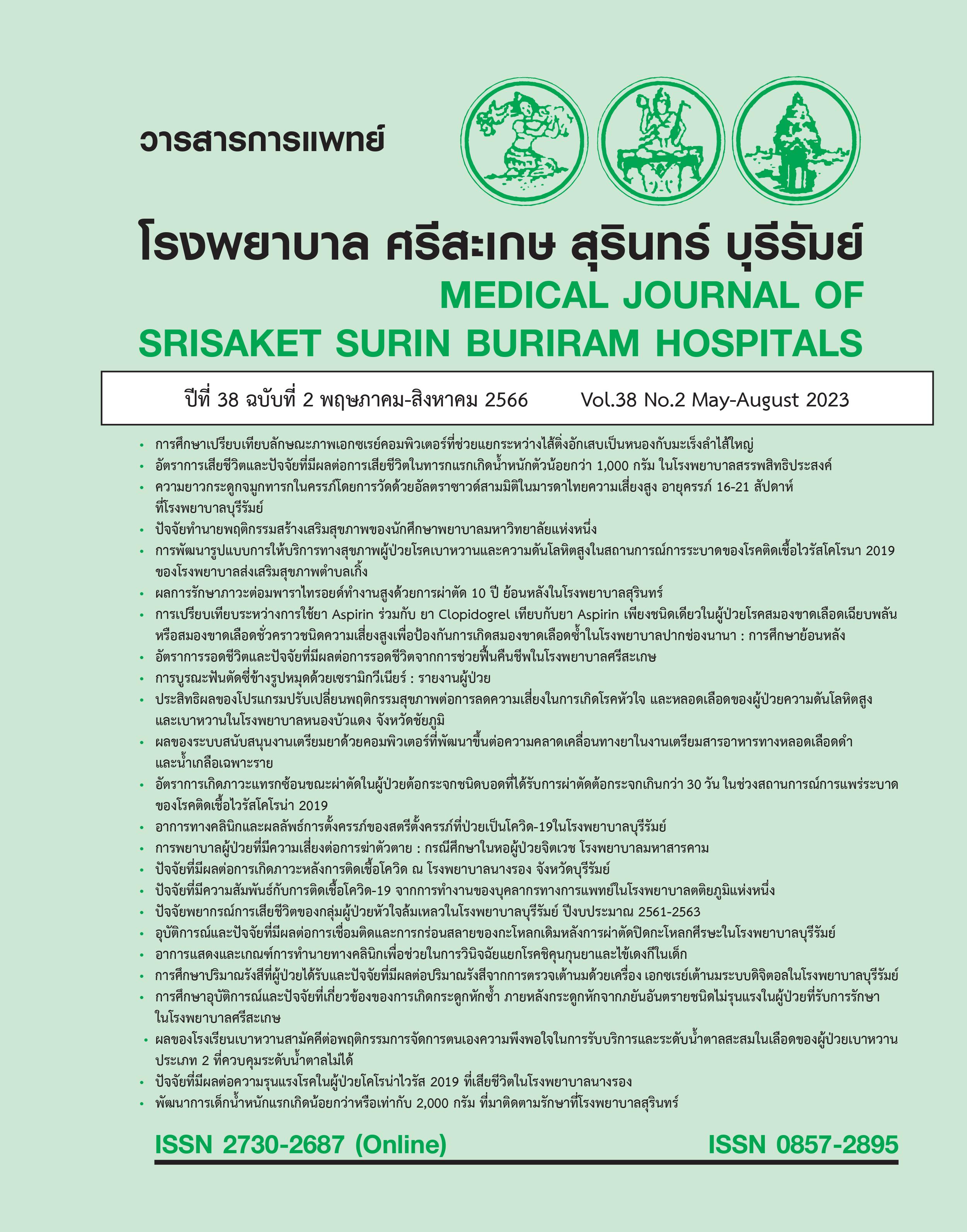Comparison of Computer Tomographic Findings Associated with Appendiceal Abscess and Colon Adenocarcinoma
Main Article Content
Abstract
Background: The patients who had an uncertain diagnosis of appendiceal abscess were concerned about malignancy. Consequently, computer tomography (CT) scan was important to differentiate benign from malignant conditions.
Objective: The aim of this study was to compare the CT findings associated with appendiceal abscess and right-sided colonic adenocarcinoma.
Methods: A retrospective study of patients who first diagnosed with appendiceal abscess and underwent abdominal CT scans. The patients were divided into two groups based on the pathological results, which included the appendiceal abscess group and the right-side colonic or cecal cancer group. CT findings were compared between the two groups, including intra-abdominal collection, lymph node enlargement, identification of abnormal appendix, appendix size, presence of fecalith, cecal wall thickness, abnormal free air, fat reticulation, colonic mass, peritoneal nodule, liver metastasis, and ascites.
Results: A total of 120 patients were included. Eighty-six patients were in appendiceal abscess group and 34 patients were in the right-side colonic or cecal cancer group. The CT findings which increased risk of the appendiceal abscess were the intra-abdominal collection, larger size of the abdominal collection, abnormal appendix, and fecalith (p-value <0.001, 0.010, <0.001, and 0.004 respectively). The CT finding that increased risk of cancer were cecal wall thickness, lymph node enlargement and colonic mass (p-value <0.001, 0.002 and <0.001 respectively). Multivariate analyses that increased risk of appendiceal abscess were intra-abdominal collection (p-value 0.047) and identified abnormal appendix (p-value <0.026).
Conclusion: Abnormal appendix and intra-abdominal collection were the CT findings favored appendiceal abscess. Conversely, the colonic mass increased the risk of right-side colonic or cecal carcinoma.
Article Details

This work is licensed under a Creative Commons Attribution-NonCommercial-NoDerivatives 4.0 International License.
References
Tannoury J, Abboud B. Treatment options of inflammatory appendiceal masses in adults. World J Gastroenterol 2013;19(25):3942-50. doi: 10.3748/wjg.v19.i25.3942.
Kim JK, Ryoo S, Oh HK, Kim JS, Shin R, Choe EK, et al. Management of appendicitis presenting with abscess or mass. J Korean Soc Coloproctol 2010;26(6):413-9. doi: 10.3393/jksc.2010.26.6.413.
Willemsen PJ, Hoorntje LE, Eddes EH, Ploeg RJ. The need for interval appendectomy after resolution of an appendiceal mass questioned. Dig Surg 2002;19(3):216-20. doi: 10.1159/000064216.
Hurme T, Nylamo E. Conservative versus operative treatment of appendicular abscess. Experience of 147 consecutive patients. Ann Chir Gynaecol 1995;84(1):33-6. PMID: 7645908
Mosegaard A, Nielsen OS. Interval appendectomy. A retrospective study. Acta Chir Scand 1979;145(2):109-11. PMID: 463439
Andersson RE, Petzold MG. Nonsurgical treatment of appendiceal abscess or phlegmon: a systematic review and meta-analysis. Ann Surg 2007;246(5):741-8. doi: 10.1097/SLA.0b013e31811f3f9f.
Thompson JE Jr, Bennion RS, Schmit PJ, Hiyama DT. Cecectomy for complicated appendicitis. J Am Coll Surg 1994;179(2):135-8. PMID: 8044380
Kim Y, Al-Sawat A, Lee CS. Laparoscopic cecectomy for complicated appendicitis using a new articulating instrument: A video vignette. Asian J Surg 2022;45(1):527-8. doi: 10.1016/j.asjsur.2021.09.025.
Sarkar R, Bennion RS, Schmit PJ, Thompson JE. Emergent ileocecectomy for infection and inflammation. Am Surg 1997;63(10):874-7.PMID: 9322662
Weixler B, Warschkow R, Ramser M, Droeser R, von Holzen U, Oertli D, et al. Urgent surgery after emergency presentation for colorectal cancer has no impact on overall and disease-free survival: a propensity score analysis. BMC Cancer 2016;16:208. doi: 10.1186/s12885-016-2239-8.
Pinto Leite N, Pereira JM, Cunha R, Pinto P, Sirlin C. CT evaluation of appendicitis and its complications: imaging techniques and key diagnostic findings. AJR Am J Roentgenol 2005;185(2):406-17. doi: 10.2214/ajr.185.2.01850406.
Suthikeeree W, Lertdomrongdej L, Charoensak A. Diagnostic performance of CT findings in differentiation of perforated from nonperforated appendicitis. J Med Assoc Thai 2010;93(12):1422-9. PMID: 21344805
Watchorn RE, Poder L, Wang ZJ, Yeh BM, Webb EM, Coakley FV. Computed tomography findings mimicking appendicitis as a manifestation of colorectal cancer. Clin Imaging 2009;33(6):430-2. doi: 10.1016/j.clinimag.2009.01.009.
Mun S, Ernst RD, Chen K, Oto A, Shah S, Mileski WJ. Rapid CT diagnosis of acute appendicitis with IV contrast material. Emerg Radiol 2006;12(3):99-102. doi: 10.1007/s10140-005-0456-6.
Rud B, Vejborg TS, Rappeport ED, Reitsma JB, Wille-Jørgensen P. Computed tomography for diagnosis of acute appendicitis in adults. Emergencias 2020;32(6):429-30. PMID: 33275365.
Lai HW, Loong CC, Tai LC, Wu CW, Lui WY. Incidence and odds ratio of appendicitis as first manifestation of colon cancer: a retrospective analysis of 1873 patients. J Gastroenterol Hepatol 2006;21(11):1693-6. doi: 10.1111/j.1440-1746.2006.04426.x.
Fiume I, Napolitano V, Del Genio G, Allaria A, Del Genio A. Cecum cancer underlying appendicular abscess. Case report and review of literature. World J Emerg Surg 2006;1:11. doi: 10.1186/1749-7922-1-11.
Chandra Mohan S, Gummalla KM, H'ng MWC. Malignant Tumours Mimicking Complicated Appendicitis and Discovered upon Follow-Up after Percutaneous Drainage: A Case of Two Patients. Case Rep Radiol 2017;2017:3253928. doi: 10.1155/2017/3253928.
Horrow MM, White DS, Horrow JC. Differentiation of perforated from nonperforated appendicitis at CT. Radiology 2003;227(1):46-51. doi: 10.1148/radiol.2272020223.
Kim MS, Park HW, Park JY, Park HJ, Lee SY, Hong HP, et al. Differentiation of early perforated from nonperforated appendicitis: MDCT findings, MDCT diagnostic performance, and clinical outcome. Abdom Imaging 2014;39(3):459-66. doi: 10.1007/s00261-014-0117-x.


